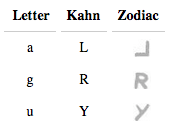Did Zodiac use Kahn’s “Codebreakers” book?
In his book Zodiac, Robert Graysmith makes this claim about the Zodiac’s 408-character cryptogram:
Fifty-five characters comprise a very complicated cipher. Was this a totally original code or had Zodiac used other sources to build his cipher system? If he had used particular books on code, perhaps these could be traced back to him.
I began by looking for basic books on secret writing. In the preface to The Codebreakers by David Kahn a sample cipher alphabet is presented; eight of the twenty-six suggested equivalents had been used by the killer. The Zodiac must have had a copy of this book.
That is a very strong conclusion. Is it true? Here’s the sample cipher from Kahn’s book:

So, if you use Kahn’s cipher alphabet on the message “CAT”, you’d get “QLK.”
Graysmith says Zodiac used eight of those equivalents. But if you look at the key to the 408-character cipher,
he really only used three of the equivalents:

For instance, Kahn says to use the symbol “R” to replace the plain text letter “G”. In the 408, Zodiac uses the symbol  to replace the plain text letter “G”.
to replace the plain text letter “G”.
How did Graysmith find eight equivalents? Well, if you swap the plaintext and cipher letters in Kahn’s table, you can find four additional matches in Zodiac’s key:

Graysmith cheated a little by treating Kahn’s cipher symbols as plain text letters. For example, Kahn says to use the symbol “C” to replace the plain text letter “E”, but we’re swapping them so the symbol “E” is used to replace plain text letter “C”. Zodiac uses  to replace “C”.
to replace “C”.
Allowing for this kind of cheating accounts for seven equivalents. But where is the eighth one? The best I can come up with is that Kahn says to use the symbol “O” to replace the plain text letter “J”, and Zodiac uses the symbol  to replace the plain text letter “O”.
to replace the plain text letter “O”.

It’s a stretch. I’m banking on the idea that “i” and “j” are close enough, leading Graysmith to include it. But the whole idea is a stretch to begin with. Still, is it possible that Graysmith was right? Could Zodiac have used part of Kahn’s sample cipher? Let’s run an experiment to estimate the difficulty of accidentally matching Kahn’s equivalents:
- Start with the Zodiac’s list of equivalents for the 408-character cipher.
- Shuffle the symbols, but retain the same number of symbols assigned per plain text letter. For example, we’ll choose seven random symbols to represent “E”, the same number used in the original cipher.
- Count the number of equivalents that are also found in Kahn’s sample cipher alphabet.
- Do the random assignments produce as many matches as Graysmith observed?
For example, here is a set of randomly shuffled assignments of the Zodiac’s symbols:

These equivalents from Kahn’s example can be found among the shuffled symbols: a -> L, c -> Q, e -> C, m -> M, n -> H, p -> I, and t -> K. If you use Kahn’s assignments in the reverse direction, as Graysmith does, then these assignments also match: K -> t, O -> j, and W -> o. So, you could claim 10 equivalents here came from Kahn’s example, but in fact they are random coincidences.
I ran 10,000 trials of randomly generated assignments, and found that 460 of them produced at least 7 equivalents that matched Kahn’s example. I’m ignoring the 8th equivalent, since it’s such a stretch. The result suggests that when Zodiac created his cipher, he had a 4.6% chance of matching at least 7 of Kahn’s equivalents purely by accident.
What does this mean? My opinion is that the 4.6% chance, combined with Graysmith’s very loose interpretation of Kahn’s example cipher alphabet, makes it impossible to conclude that Zodiac must have used Kahn’s assignments. Maybe Zodiac really did use Kahn’s book, but Graysmith’s idea does not sufficiently prove this.
Nevertheless, maybe there is something else in Kahn’s book, or in a similar book available in Zodiac’s time, that more conclusively lines up with how the killer constructed his mysterious ciphers.